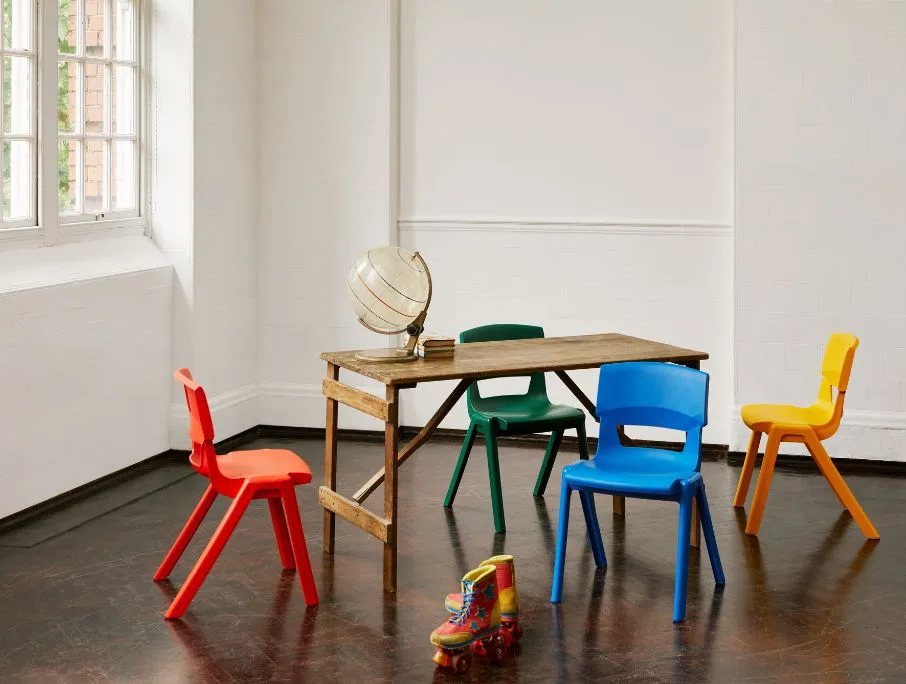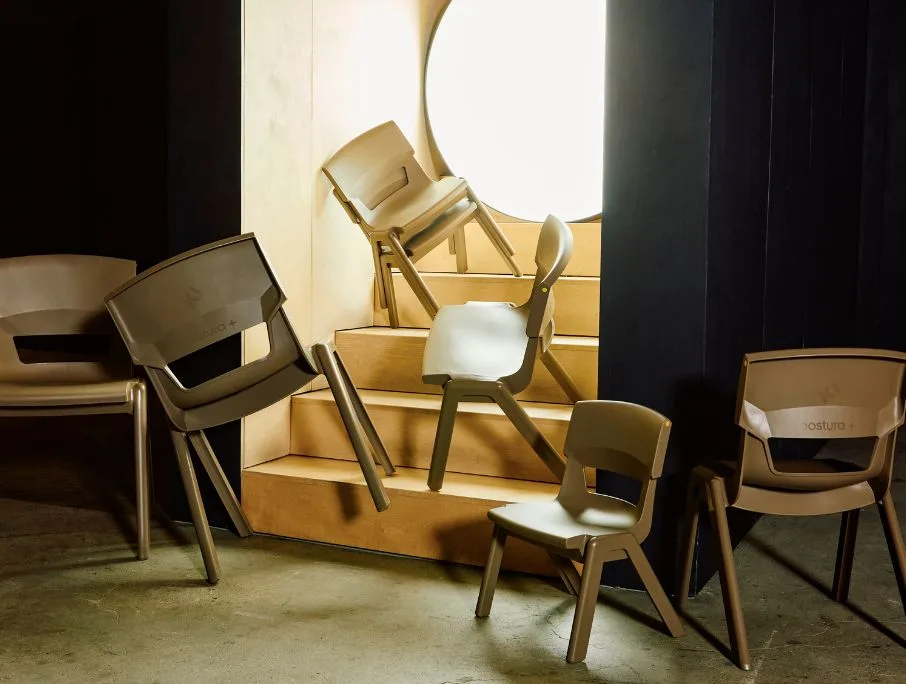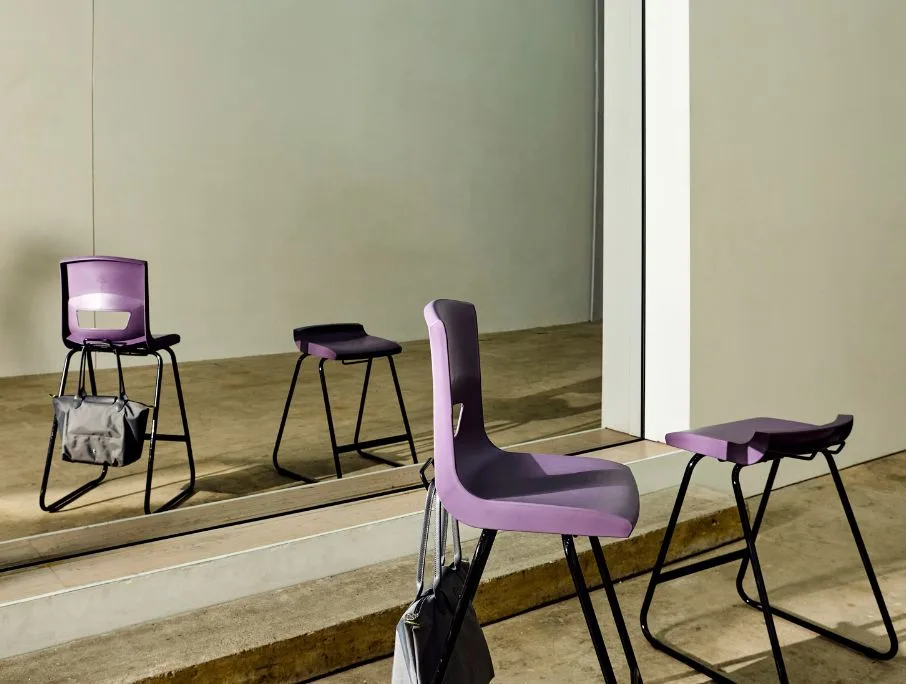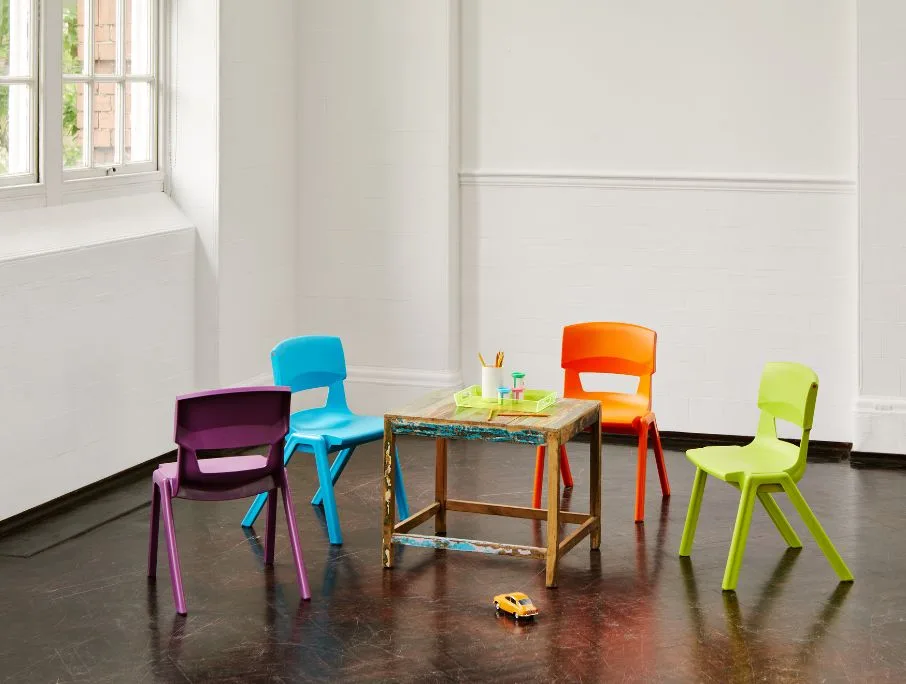The Benefits of Ergonomic Classroom Chairs
While aspects of educational settings echo times gone by, much about today’s classrooms reflects a more modern outlook. The old one-size-fits-all approach has been replaced by active learning experiences that require more flexible learning environments. We’re more aware of children’s well-being and how classroom furniture can impact that.
Ergonomic furniture is specifically designed to support the body and promote good posture, reducing the risk of discomfort or pain. You may associate back pain with getting older, but it’s surprisingly common amongst young people too. According to NHS research, a staggering 72% of UK primary school children and 64% of secondary school children have suffered with back or neck pain in the last year. This isn’t solely down to poor posture and seating positions, but it’s definitely a contributory factor.
Investing in well-designed ergonomic classroom chairs and desks can transform the learning experience and contribute to healthier, more productive students and teachers. We’ll explore this idea in more detail below.
What is ergonomic design?

First things first, let’s explain what’s meant my ergonomic design. The concept of ergonomics is about designing environments and products to align with human anatomy and behaviour. It’s a human-centric approach.
To take ergonomic chairs as an example, they’re designed for better posture and comfort. They’ll incorporate features like adjustability, a sculpted shape and lower back support.
The need for ergonomic classroom furniture
In days gone by, school chairs were wooden, rigid and uniform. For many, they were pretty uncomfortable. Fortunately, we’ve progressed a long way from there. Today’s school furniture tends to be designed with comfort, support and practicality in mind.
Ergonomic classroom furniture isn’t just a nice to have. Since January 2007, it’s been a legal requirement too. The British and European Standard – BS EN1729 Part 1 – relates specifically to educational institutions. It ensures that school furniture meets the appropriate size, shape, and ergonomic design to promote good posture, and reduce repetitive strain injury (RSI) and back pain in students.
How do ergonomic classroom chairs benefit students?

Traditional desks and chairs, while functional, may not support proper posture, comfort or engagement. That’s where ergonomic furniture comes in. Investing in well-designed ergonomic seating and desks can transform learning experiences and contribute to healthier, more productive students. There are seven key reasons why.
1. Promotes better posture and comfort
When we slouch, slump, perch or lean, we place undue pressure on our bodies. Ergonomic furniture’s designed to support natural spinal alignment, reducing strain on the back, shoulders, and neck. Adjustable chairs and desks suit students of various heights and body types. Chairs with lumbar support and backrests reduce discomfort. These thoughtfully-designed chairs ensure a comfortable and supportive learning experience.
2. Enhances focus and productivity
Discomfort and poor posture can be significant distractions in the classroom. If students are experiencing aches and pains, or struggling to get comfortable, it reduces their ability to focus on the lesson. Ergonomic furniture minimises those distractions by providing well-supported seating that encourages concentration. When students feel comfortable, they’re more engaged and can better absorb information.
3. Encourages active learning
Modern ergonomic furniture often includes flexible seating options like wobble stools, balance balls and tilted stools. They’re adjustable, movable and dynamic. They encourage fidgeting and movement. That activity increases blood flow and oxygen to the brain which improves cognitive function and retention. Active learning environments foster creativity, participation, and overall enthusiasm amongst students.
4. Reduces physical strain and fatigue
Sitting for prolonged periods is detrimental to health. Muscles feel tense, fatigue sets in and it can lead to long term health issues. Ergonomic classroom furniture is designed to minimise pressure points, reduce muscle strain, and provide better support. It’s also important for students to get up and move around, shake it out, and change their position. That all helps students to feel more energised and enthused.
5. Supports student health and wellbeing
The habits students develop in their early years often carry into adulthood. By providing ergonomic furniture in classrooms, schools can instil healthy posture habits that students will take with them into their future lives. This proactive approach can help reduce the risk of chronic pain and other health concerns later in life.
6. Accommodates diverse learning needs
Accessibility is another important aspect to consider when choosing classroom chairs. Every student learns differently, and ergonomic furniture can cater to diverse learning styles. Some students may benefit from wobble stools that encourage active sitting, while others may need more supportive seating to feel comfortable. Providing a variety of seating options can create an inclusive environment that meets the needs of all learners.
7. Robust and durable
Ergonomic classroom chairs are fit for purpose and likely to withstand a vast array of activities. Think about how classroom furniture is used in a typical day. It isn’t just for writing and computer work. It may involve creative paint and glue sessions; science experiments; construction and design technology; and even packed lunch. Being easy to clean, stain-resistant and durable is an absolute must for classroom furniture.
What are the benefits for teachers too?

It’s important to consider teachers’ needs as well as those of students. They often have long working days – it doesn’t end at 3pm when the school bell signals home time for students. Comfort and postural support are important for teachers’ long term health too.
Classroom furniture for young age groups is usually at a low height. A height adjustable seat is a must for staff working with children. By lowering the seat height, teachers and teaching assistants can be at eye level with their students, and avoid back pain.
Swivel chairs on castors (typical office chairs) also work well for adults in a classroom environment. It enables staff to move about, turn around and reach equipment easily.
Flexible seating and classroom layouts support different ways of teaching and student interaction. For example, moving classroom furniture to form the best seating arrangement to suit the learning activity. That could be as simple as stacking chairs to make more space for students to move around and engage in group activities. Or perhaps bringing in additional stackable chairs and folding tables to use occasionally rather than every day.
Supporting different learning environments
Particularly in senior schools, colleges and universities, there are designated learning environments for certain subjects. Take a science lab for example. The workstations are typically at a higher level than a regular classroom desk. Similarly, an IT workstation will have a different layout and furniture requirements. High task chairs or stools are ideal for IT workstations or science labs. Ergonomic high task chairs and stools will still provide lumbar support and are easy to adjust for individual needs.
Older age groups often use more relaxed learning environments. Instead of classroom tables and desks, task chairs with tablet arm rests can be used for example. That option provides plenty of versatility for seating arrangements and classroom layout.
Case study
“It was important for us to have an unbreakable chair which was also extremely comfortable for the children to sit on all day. We found the Postura+ chair to be the most comfortable and the 20-year warranty gives us piece of mind. We also loved the fact that it brought bright colours to the classroom.” Mariana Gurmann, Founder of MeinBrain School, Frankfurt, Germany
Read the MeinBrain School case study in full
Our Postura+ chair is the ideal classroom seating solution

We recognise that the shift toward ergonomic furniture in classrooms isn’t a passing trend. It’s an essential step towards improving education and student wellbeing. By prioritising ergonomic designs, schools can create environments that support posture, enhance focus, and promote overall health. Investing in high-quality, adjustable furniture ensures that every student has the opportunity to learn comfortably and effectively. That’s a win-win for students and teachers alike.
If you’re considering upgrading your school’s furniture, check out our range of ergonomic education furniture as well as office furniture for your admin staff. Loved by educators worldwide, KI’s iconic Postura+ range is the most trusted name in education. These vibrant chairs are renowned for their comfort, durability and versatility. Made from high impact resistant copolymer polypropylene, they’re easy to clean and 100% recyclable. Available in a wide range of seat colours from a vibrant red to a muted light grey, the diverse colour palette suits any learning environment. Optional seat pads add extra comfort and support.
Postura+ Reverse Cantilever Chair
KI Postura+ 4 Leg Chair On Castors
